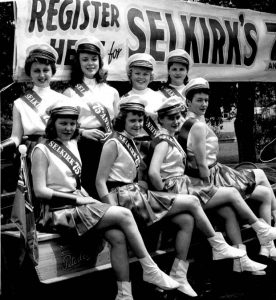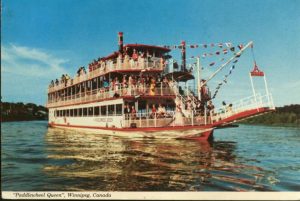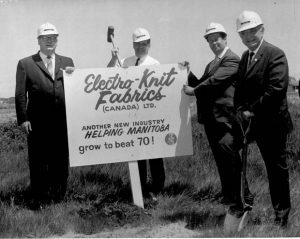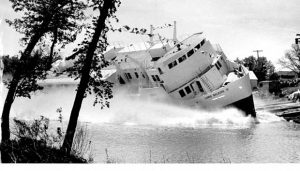The Modern Town 1947-1979
1947
The Devonshire Collegiate building became an elementary school
1948
The original Garry Theatre was built by Rothstein Theatres Ltd
1948
A 40,000-bushel wooden grain elevator was built by Manitoba Pool Elevators
1949
A new Selkirk Co-operative owned grain elevator was opened
1949
Memorial Hall was built and the Selkirk Arena was rebuilt after collapsing
September 24, 1949
The first ice-free event took place in the new Selkirk Arena
December 9, 1949
Official opening of Selkirk Arena hosted by the Kinsmen Club of Selkirk. The first hockey game was played at the arena the following day on December 10th
May 24, 1949
Selkirk Park re-opened after the Great Depression
1950
Fifteen people were employed at the new Coca-Cola bottling plant
1950
There was widespread flooding in April and May due to heavy snowfall in the winter and 2 x the normal rainfall in the spring
1951
Daerwood school was built to replace South-Ward School. The school division turned to its pupils to pick a name for the new school. The winning essay came from 10-year-old Barry Gordon, son of mayor William E. Gordon
1951
The Dinette opens on Manitoba Avenue
1951
The Manitoba Rolling Mills began a $1,000,000 expansion that created work for another 100 people
1951
6,218 people resided in Selkirk
September 21, 1951
Memorial Hall‘s sod turning ceremony with W.E. Gordon given the honour of breaking ground first
December 31, 1951
Memorial Hall’s first event, a New Years Eve Dance
January 17, 1952
Official opening of Selkirk Memorial Hall
1952
First Nations people were granted the right to vote in Manitoba provincial elections
1952
The Robert Smith Memorial Scholarship is presented for the first time
1953
Bethel Church began construction
1953
The Infirmary Unit opens at the Selkirk Hospital for Mental Diseases
November 29, 1953
The first Robert Smith Memorial Scholarship is awarded to grade 11 student, Roman Strawa
1954
The Garry Theatre suffered from a major fire in January. A new theatre was built and opened in April
1954
The Selkirk Fair was “revitalized” after the war and in 1954, it boasted the largest dairy cattle exhibition in the entire west and the participation of more than 400 4-H clubs
1954
258 leucotomies have been performed at the Selkirk Hospital for Mental Diseases
1955
Approximately 5,000 people attended the opening of the new hospital
1955
E. R. Gardner’s Selkirk Silica Company Limited was organized
1955
The Dyson Pickle Plant began operation
1956
The Grace Baptist Church was organized
1957
The post office moved to a new location a few blocks south on Main St
1957
A new building opened for the Holy Eucharist Ukrainian Catholic Church. It was funded by a procession of 300 people from the old Greek Ukrainian Catholic Church and was built mostly from volunteer labour
1957
1200 patients resided at the “Selkirk Hospital for Mental Diseases” (Now known as the Selkirk Mental Health Centre)
1958
Ruth Hooker School was built. The school was named after the Chair of the Selkirk School Board
1958
The first expansion to Gilbart Funeral Home was complete with a new chapel
June 28, 1958
The World War II and Korean War expansion was added to the monument at the Veteran Memorial Gardens
August 4, 1958
Rotary Lake opened to the public
1958
The present sanctuary of the Selkirk United Church was built
1959
A new school was built and was named after Robert Smith. He was Manager at the Rolling Mills, first Vice-President of the Selkirk General Hospital Board and a past Mayor of Selkirk
1959
The Carnegie Library was demolished for a new municipal office
1960
300 workers were laid off at the Rolling Mills due to fierce competition in the steel industry. Negotiations with the Untied Steelworkers of America Local 5442, threatened to strike if a new contract was not in place by August. The layoff of 120 more workers at the Rolling Mills triggered a 92-day strike
1960
First Nations people gained the right federally to vote without having to give up their status and treaty rights
1960
Rotary lake damaged due to spring flooding
1961
The Jemima Street Curling Rink was built
1961
Selkirk Bowling Lanes opens
1961
The previously mentioned Steelworkers strike ends when most of the men were rehired to provide steel for the Manitoba Power Commissions hydro-electric project at Grand Rapids
1961
A new water tower was built replacing the old one built in 1909
1961
8,576 people resided in Selkirk
1961
The Selkirk Hospital for Mental Diseases opens a community clinic with teams working inside and outside the hospital
1962
The Selkirk Curling Club opened a new facility
1963
A multi-million dollar modernization of the steel plant commenced but resulted in few new jobs as the work was of an automated nature
1964
The Selkirk Psychiatric Institute (S.P.I.) opens at the Selkirk Hospital for Mental Diseases
1964
Gilbart Funeral Home saw another expansion, with the addition of an embalming room and a heated garage. A new Oldsmobile and a two-stretcher ambulance were added to the fleet
1965
The S.S. Keenora was decommissioned
1965
The semi-pro rodeo was added to the Selkirk Fair and Rodeo program
1967
Consolidated Plastics, with about a projected 30 workers was built in the Industrial Park
1967
Ruth Hooker School and Victoria School amalgamated becoming Victoria-Ruth Hooker School
1967
The Lord Selkirk School Division No. 11 was created
1967
Newly renovated Rotary Lake reopens
September 4th, 1967
The Selkirk Friendship Centre was created
1968
Futronics opened a facility to manufacture electronics circuitry
1968
The Red River Floodway is completed
1969
Narco Drugs opened a pharmaceutical manufacturing facility in the Industrial Park
1970
The Adolescent Treatment Ward opens at the Selkirk Hospital for Mental Diseases and the Mobile Clinic services The Pas, Flin Flon, Leaf Rapids, Snow Lake, and Thompson
1971
Lord Selkirk Regional Comprehensive Secondary School was built. The Selkirk Collegiate becomes Selkirk Jr. High
1971
The Victoria-Ruth Hooker School was renamed Ruth Hooker School
1972
The Marine Museum of Manitoba was established
1972
The annual Christmas dinner’s begun by Elsie Bear at her home were moved to the Selkirk Friendship Centre where over 300 people could be fed each year.
1972
The Adolescent Ward, B-Unit closes at the Selkirk Hospital for Mental Diseases when community-based treatment became more widespread
1973
A new $2 million laundry facility was constructed for the Mental Health Centre and Winnipeg’s three municipal hospitals
1973
The Selkirk Hospital for Mental Diseases changes its name to the Selkirk Mental Health Centre
1975
Gaynor Foods opened
1975
The Selkirk Friendship Centre began construction at the present location
1976
The Marine Museum purchased the C.G.S. Bradbury
1977
A new maximum-security federal prison was proposed for near the town. Due to vocal opposition to the proposal, the town council held a referendum on the issue with two to one being in favour of it
1978
The proposed prison was withdrawn due to a drastic restraint program
1978
The Main building at the Selkirk Mental Health Centre is demolished, marking a significant point in the Centre’s history
1979
The Old Post Office was condemned as unfit for human habitation











